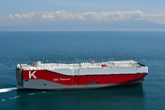Small scale LNG ambitions
Published by Callum O'Reilly,
Senior Editor
LNG Industry,
A severe drop in oil prices is having a knock on affect in the LNG industry. With more LNG available than clients buying, it is a crowded market.
However, with good margins for clients to switch from traditional fossil fuels to gas, the outlook is encouraging for Håkan Werner, Vice President of Business Development LNG, at IM Skaugen.
Covering current and future business strategies, Håkan has revealed to CWC - organisers of the Small-Mid-Scale LNG Summit taking place in Amsterdam, the Netherlands, in June 2015 - what small scale LNG ambitions the company has in the pipeline for its continued and future growth.
“The last years’ realignment around IM Skaugen’s business of liquefied gas transportation and successful divestment of non-core activities has made IM Skaugen a leaner and a more focused company. The company has created a platform for the future and a strong competitive position both within its traditional petrochemicals markets and the developing small scale LNG energy markets.
“The energy market in general and the small scale LNG market in particular remain the company’s focus areas to generate future earnings and growth. We have the ambition to become the ‘go-to’ specialists for regional LNG distribution. The company can offer a unique value proposition combining the Norgas LNG capable vessels with the competence of the Group’s SPT company; which can provide consultancy and advice as well O&M management of LNG terminals. Through this the company can provide a complete logistics solution for regional distribution of LNG on a global level.
“We have firm belief that small scale LNG will become a key market for us. It has taken longer to achieve, but we do believe we will get there. We have made substantial investments to develop our small scale LNG concept. The cargo system we developed for the multi-gas vessels is unique and contains many novel technologies. It can handle a wide range of gases including LNG and keep them cool during transport without any losses. We have also invested close to US$15 million in R&D as well as market and concept developments. The latter includes equipment and systems for transferring (ship-to-ship), storing and re-gassing of LNG.
“In many countries state fiscal reasons do also require that fuel subsidies now need to be removed. This will ensure that gas is cheaper than diesel fuel and the economics for gas distributed as LNG will be there for two key market segments. Firstly, remote power plants where more expensive diesel is the alternative fuel due to lack of gas supply through pipelines. Secondly, the transportation market as fuel for trucks, buses and cars as well as ships. Diesel and petrol are far too valuable products while abundant and lower cost gas should become the transport fuel of the future. Due to its composition, natural gas is the fossil fuel with the lowest emissions. Compared to conventional fuels it will generate no SOx emissions, reduce NOx emissions with 80 - 90% and reduce CO2 emissions with 20 - 30%. For both these market segments, one of the key enablers will be the availability of small scale LNG supply chains where the gas is delivered in its liquid form and in smaller quantities to multiple locations. Our fleet of six LNG capable vessels could easily be deployed in LNG service as and when needed.
“The company […] continued to do some LNG business in 2014. Together with a team of specialist[s] from the Group’s SPT company and using one of our multi-gas carriers, we performed a gas-up and cool-down operation for a conventional LNG carrier at sea, making it ready to load LNG without occupying expensive time at the loading terminal. The company also commenced a shorter term contract for coastal distribution of LNG in China.
“Looking forward we are encouraged by the signals from our key markets, including the small scale LNG market, where our unique fleet of LNG capable multi-gas vessels can be made available for long-term LNG trade on short notice. There is now more LNG available than there are clients capable of buying and thus a severe drop in prices has made it even more affordable. We see a good margin for clients to switch from naphtha or diesel in power plants to gas. Many of these power plants can realise savings that enable the repayment of switching cost and the added infrastructure and logistic cost in a short period of time. Our LNG capable ships are unique and available to service these.”
Håkan will be speaking at CWC’s Small-Mid Scale LNG Summit.
Edited from press release by Callum O'Reilly
Read the article online at: https://www.lngindustry.com/small-scale-lng/06042015/small-scale-lng-ambitions-537/
You might also like
‘K’ Line receives LNG-fuelled car carrier
An LNG-fuelled car carrier with a capacity of 6900 vehicles has been delivered to Kawasaki Kisen Kaisha, Ltd.


